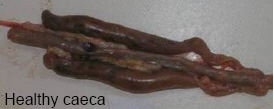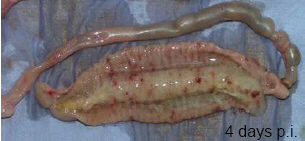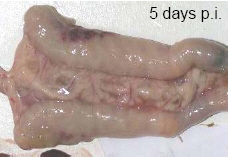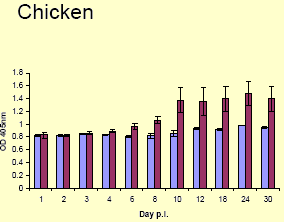



Histomonosis and the Differential Survival of Poultry Species
Since an EU ban on nitroimidazole treatments in 1995 and a greater tendency towards outdoor production of turkeys, incidence of Histomonosis (Blackhead disease) have been increasing, writes Chris Harris, Senior Editor, ThePoultrySite.In the 1920s the disease was one of the main causes of loss to the turkey industry but, with the development of therapeutic medicines, outbreaks declined up to the time of the EU ban.
The disease has also become more prevalent with changes in farming practices and moves to produce more birds under free range conditions. Both chickens and turkeys are susceptible to the disease but while chickens can recover and become resistant to it, turkeys are harshly affected and often die. Mortality can be as high as 80 per cent.
This disparity between the affect the disease has on chickens and turkeys led to research by doctorate student Fiona Powell and scientists at the UK Institute of Animal Health, backed by funding from the British Poultry Council, to discover whether the immune response contributes to the differential survival of poultry infected with Histomonas.
According to Dr Powell, the chicken provides a model of resistance to which the turkey can be compared.
In chicken, the infection starts to disrupt the villi in the caeca of the bird within five days and within 12 days there is a thickening of the caecal wall and the formation of a caseous core. However, after 16 days the villi start to reform and within a month the bird recovers.
 |
| Healthy caeca. |
For turkeys, however, the caecal structure is disrupted after three days as the histomonads invade and lesions start to develop. The caecal wall thickens and a hard core develops after four days but unlike in the chickens, in the turkeys there is no healing of the lesions.
The disease then starts to attack the liver as a secondary infection and within eight days necrotic foci develop.
The research experiment carried out a series of tests on young birds, including RTPcr tests, immunohistochemistry tests and Elisa tests on antibodies.
 |
| Caeca after four days infection. |
Dr Powell said that three quarters of the chickens tested recovered after 30 days, but although they recover, they act as a carrier for the disease.
The initial reaction from the turkeys was similar to that of the chickens. Between days six to 12 both turkeys and chickens saw a rise in infection, but while in chickens there was a reduction after day 12 in turkeys it continued to rise.
"The significant difference occurs in the liver," said Dr Powell.
"In chickens we saw an antibody response, but in turkeys we saw nothing like the same antibody response."
 |
| Caeca after five days infection. |
Dr Powell concluded that in chickens there is an early effective innate response that limits protozoan movements to the liver. She said that this adaptive response controls pathology in caeca and liver. She said that there is limited cellular influx, a high antibody response and the Protozoa are confined to the caecal lumen.
In turkeys, however, there is a lack of innate caecal response and the protozoa move to liver in greater numbers. The caecal pathology does not recover and there is excessive cytokine and cellular response in liver. She said that there is also a less evident antibody response.
In the case of the chickens their reaction to the infection is to become an asymptomatic carrier, while the turkeys showed a high mortality rate.
Antibody Response


She said that the response of the turkeys could be caused by genomic differences and pathogen recognition. She said that cytokines show a high identity between chicken and turkey, but nonetheless several differences do exist, which should lead to further research.
Further Reading
| - | Find out more information on Histomonosis by clicking here. |
March 2008








